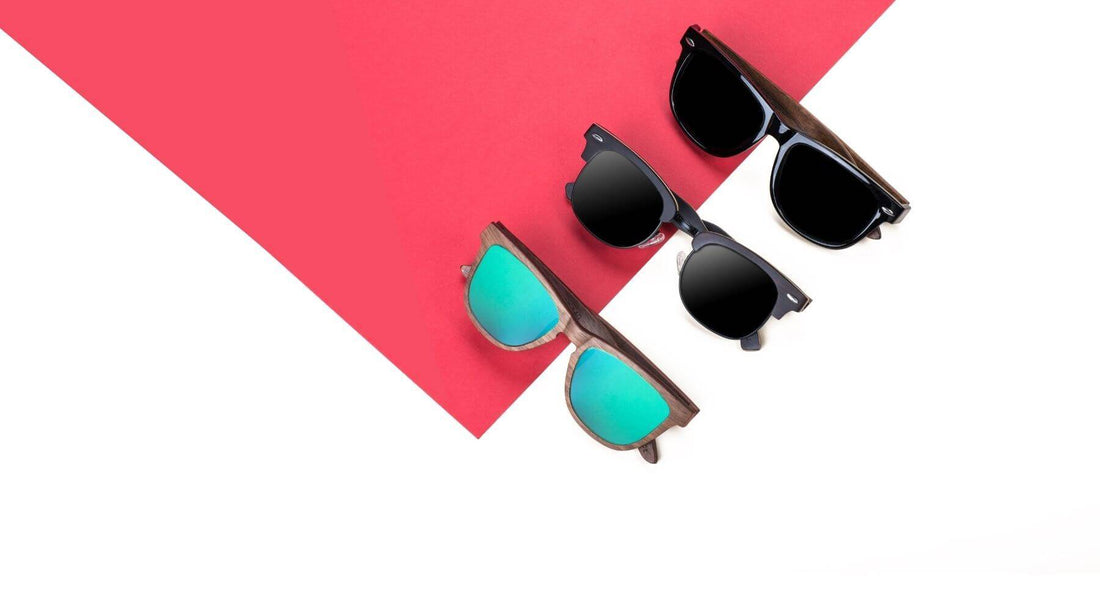
What is the Difference Between Polarized And Non Polarized Sunglasses
Difference Between Polarized And Non Polarized Sunglasses
8 Minutes read • Updated 18 February 2025 • Heba from Kraywoods
Ever experienced any difficulties when shopping for sunglasses? There are plenty of details that one must look at before choosing the right pair. One of the most common questions you might ask yourself is “What type of lens protection is best, and do I really need polarized sunglasses?”.
Both polarized and non-polarized sunglasses give your eyes shade on a bright sunny day. But the similarity ends here. We often hear about polarized sunglasses being better for our eyes and that they offer more sun protection. So, what is really the difference between polarized and non-polarized glasses? Here's what you will find out:
- What is Polarization?
- How are Polarized Sunglasses are working?
- Benefits of Polarized Sunglasses.
- Benefits of Non-Polarized Sunglasses.
- Polarized and Non-Polarized Sunglasses.
- What to Look for When Buying Polarized Sunglasses?
- How to Identify Polarized Sunglasses.
What is Polarization?
It is vital to first understand that light is delivered through reflected waves. Light waves that reflect in more than one place/direction are called non-polarized light. On the contrary, polarized light waves are those that reflect in a single place/direction.
The non-polarized light travels in both horizontal and vertical directions. However, horizontal light is more problematic because it creates potentially dangerous and unwanted glare by bouncing off different surfaces. This is the major dissimilarity between polarized and non-polarized light.
How do Polarized Sunglasses Work?
The light entering your eyes is coming from all sorts of directions, causing significant glare and disturbances in your vision. Non-polarized lenses don’t filter light the same way as polarized lenses. They have a minimal affect on the direction of the light waves.
However, polarized lenses are coated with a thin layer that filter these light waves to make them polarized. In other words, lenses take in the non-polarized light reflections coming in from all sorts of directions and filter them. As a result, the light entering your eyes will cause fewer disturbances to your vision.
There is a never-ending debate between polarized and non-polarized sunglasses in terms of the way they work and which is more suitable. It's safe to say that both lenses can provide UV protection from UVB& UVA other than bright light. So, this can be a tough decision to make.
Watch Below: Polarization of Light
Benefits of Polarized Sunglasses
Although there are a few downsides to polarized lenses, they are better equipped. These lenses have a polarizing filter that gives them advanced anti-glare and anti-reflection protection. The filtered layer helps cut all the reflective glare. In addition, it enhances color contrast and delivers better visual clarity. No wonder they're the top choice for drivers, hikers, and athletes! Let's explore more in detail the benefits of polarized lenses:
- Eliminate Reflective Glare: This is the first and most important benefit. It’s great for any outdoor activity, such as downhill skiing. You’ll be saved from shiny glared and harmful UV rays.
- Reduce Eye Strain: Polarized lenses will eliminate the reflective glare causing your eye fatigue.
- Increase Visual Comfort: Visual comfort in daylight is crucial so, if your eyes are constantly interrupted by bright horizontal light rays, you can get tired.
- Enhance Contrast: With polarized sunglasses for women and men, colours remain bright and stand out even more.
Vision Through Groove Polarized Sunglasses
Benefits of Non-Polarized Sunglasses
Everything has it's own set of advantages and disadvantages, even non-polarized sunglasses. As mentioned earlier, it can be difficult to choose between the two. But, it all depends on your lifestyle and how you want to see things. So, here are the benefits of non-polarized sunglasses:
- Non-polarized sunglasses have protection coating against UV damage.
- Non-polarized sunglasses reduce the overall intensity of sunlight in your eyes.
- Non-polarized sunglasses make it easier to read a computer or a phone screen.
The Difference between Polarized and Non-Polarized Sunglasses
Non-polarized lenses decreases the glare of all kinds of light, but don't eliminate them. They make it easier to see in strong light conditions, yet they don't affect the glare we may experience or clarity and colour contrast of the images. They mostly decrease the amount of light getting into your eyes.
So, you don't have to choose between polarized vs non-polarized for golf. You'll know the right glasses frames to go for. But, let's point out some crucial differences between these two types of sunglasses.
1. The Outdoors
When you are outdoor during the day, that's where you'll notice the big difference between the two. The particular layer of polarized lenses are anti-reflective surface, which completely rids you of reflections, glare and haze.
Polarized sunglasses are a good option for fishing. When you look at an ocean or lake through these sunglasses, you will see past most flat surface reflections and through the water underneath. Moreoever, the anti-glare properties of these sunglasses are excellent for a picturesque view of the horizon.
Lastly, polarized sunglasses are great for countryside hikes too because the polarizing filter in the lens increases colour contrast in the daytime. The Racer sunglasses crafted from walnut wood and equipped with green mirror polarized lenses are the perfect pair for your next hike. Sturdy and lightweight, these polarized shades will provide you ultimate comfort, protection and style!
2. Driving
Polarized vs Non-Polarized for driving? Let's see, polarized sunglasses can be a life saviour when you drive on a sunny day. Its lenses help filter the sunlight that reflects off snow, roads, and windshields, counteracting most or even all of it. The result is a safe driving experience.
You should know that driving with polarized sunglasses for women and men in some snowy or icy conditions might be less safe than using non-polarized ones. Some people may feel like non-polarized sunglasses perform better with the lesser contrast of total cloud cover. Any coverings of iced snow or black ice, which is already hardly visible, might become even harder to see without surface reflections.
The Ralph sunglasses offer top-notch protection for your eyes. Handcrafted from layers of rich walnut and ebony wood, these round polarized glasses equipped with dark grey polarized lenses block out harmful UV horizontal light rays, so you can rock them while driving around all day long and enjoy superior visual clarity and comfort.
3. Screen usage
Digital led screens may appear distorted when seen through polarized lenses. The images on the LCD screen will appear somewhat faded or completely dark depending on the position or angle from where you see the LCD screen. "Do sunglasses block blue light?" is often asked by people looking to buy high quality sunglasses. If you experience digital eye-straining symptoms, we recommend you talk to your eye care professional. He might prescribe different lenses coating depending on your case. Who knows, the eye doctor might prescribe blue horizontal light rays blocking glasses to feel more comfortable in front of LCD screens.
4. Prescription
You will find both polarized and non-polarized sunglasses with prescription and non-prescription lenses. Polarized prescription lenses commonly involve an extra charge on top of the included primary polarized lens options, but it doesn't always happen. Some eyewear brands add polarization as a standard feature or even offer it for free. Make sure you check the label to find out what options you're getting. At Kraywoods, all sunglasses are already equipped with premium TAC polarized lenses, offering superior visual clarity and comfort.
What to Look For When Buying Polarized Sunglasses?
Finding the perfect pair of men's polarized sunglasses or women's polarized sunglasses is not the easiest job. As mentioned earlier, you can find both polarized and non-polarized sunglasses with prescription and non-prescription lenses. All you have to do is pay attention to the label. But, what about other factors? Let's find out what they are:
1. Functionality
Before deciding on purchasing any sunglasses, you need to consider their everyday use first. This is where the functionality of the frames comes in.
The type of hinges on the frame can be very important. Hinges are the link and screw that link the front part of the frame to the arms on the side. Sunglasses that are equipped with spring hinges offer superior comfort as they make your frames flexible and don’t put any pressure on your temples.
2. Durability
Next up, is durability. Wooden frames are also very durable as they are made from many layers of laminated wood. Often, the wood is recycled or sustainably sourced and the sunglasses are handcrafted and therefore eco-friendly. Wooden frames, specifically wooden polarized sunglasses, offer a beautiful design and aesthetic, all while ensuring extra durability.
3. Lens Tint & Colour
Sunglasses lenses come in different tints and colours. The tint on the polarized lenses filters lights in many ways. Some tints even do a better job at blocking the light than others. In addition, some tints enhance colours while others distort colours. In certain situations, some can improve vision.
You may have certain preferences of tint colour, but it may not be suitable for your needs. Here are 6 different tints and their uses:
- Grey
Grey tinted polarized lensesare a popular choice for sunglasses due to their ability to allow for the perception of colors in their purest form. This tint helps to reduce glare and brightness, making it a great choice for activities such as driving, operating heavy machinery, outdoor sports like running, golf, or cycling. The Rover Sunglasses, for example, are a top pick for their quality grey polarized lenses. These polarized sunglasses are perfect for those who are looking for eye protection from the sun's harmful rays while still being able to see colors as they truly are. Whether you're behind the wheel or participating in outdoor activities, the grey tint is an excellent option.
- Yellow/orange
Yellow and orange tints are effective in improving contrast in poor visibility conditions like fog, haze, and low light. Yellow-tinted sunglasses provide a clearer and sharper view of objects both indoors and outdoors. However, it is important to note that these tints may cause some colour distortion. Yellow and orange shades are ideal for sports activities such as indoor ball games and outdoor snow activities where good visibility is crucial. In conclusion, yellow and orange tints can be useful for certain scenarios where clear vision is necessary, but it is important to weigh the trade-off with colour distortion.
- Green
Green tints in sunglasses filter blue light and reduce glare for improved visual sharpness and high contrast. This makes them suitable for precision sports such as basketball, tennis, and golf. Green shades also relieve eye strain in bright light, making them a popular choice for outdoor enthusiasts and athletes. The Runner Sunglasses are a great option for those who want to experience the benefits of green tints in a stylish and functional pair of polarized sunglasses.
- Brown/Amber
We now move to amber and brown tints. They help reduce glare and block blue light. These polarized sunglasses increase visual clarity and contrast by blocking blue light, particularly against blue and green backgrounds like sky and grass. We recommend polarized sunglasses for fishing, baseball, hunting, water sports, golf and cycling.
- Melanin
It is said that melanin tints in polarized sunglasses can help to prevent the harmful effects of sun exposure on the eyes, which can cause premature aging and other problems over time. Hazel sunglasses, for example, have been shown to be particularly effective in this regard, particularly for people who suffer from macular degeneration. This is a condition that can cause significant vision loss, particularly in older adults. By wearing polarized lenses that contain melanin tints, people with macular degeneration can help to reduce glare and their risk of developing further vision problems and maintain good eye health.
- Red/Rose
Rosy tints, also known as red or rosy tints, are a popular choice for polarized sunglasses and other eyewear. These tints are known for their ability to increase contrast and block blue light, which can be harmful to the eyes. Additionally, they have a reputation for providing visual comfort, making them a good choice for people who need to wear wear polarized sunglasses or glasses for extended periods of time. Try our Elton Sunglasses ! The soothing effect of rosy tints also makes them a popular choice for driving, as they can help improve visibility and reduce glare. When working on a computer digital screens, the rosy tints can also help to reduce glare and eye strain, making them a preferred choice for people who spend a lot of time in front of a computer monitor.
How to Identify Polarized Sunglasses?
You can do a quick little simple test by yourself. First of all, put the glasses on and then have a look at LCD screens such as your laptop, smartphone, tablet or car dashboard. If you can see a rainbow in your line of vision hindering your view of the led screen, then the lens is most likely polarized.
Keep in mind that some companies use traditional polarized lenses, while others use thinner polarization. If your sunglasses are equipped with slimmer polarized lenses, then you will be able to look at your LCD screen with less distortion.
There is another test that you can do: try wearing your sunglasses in the sun and test your vision through the polarized lenses. When wearing polarized sunglasses you shouldn't experience blurring in your vision or see any glare or reflections.
So, which one will you go for? Most people go for polarized sunglasses because of the wider advantages. They help people who are experience discomfort in the sun and are sensitive to the reflected light. Your eyes deserve the best care and protection. And, our wooden sunglasses with HD polarized lenses can give you exactly what you're looking for.
Whether you choose polarized or non-polarized sunglasses, it's important to ensure that they provide adequate UV light protection for your eyes. Always look for sunglasses that meet the standards of the American National Standards Institute (ANSI) and the International Organization for Standardization (ISO).











